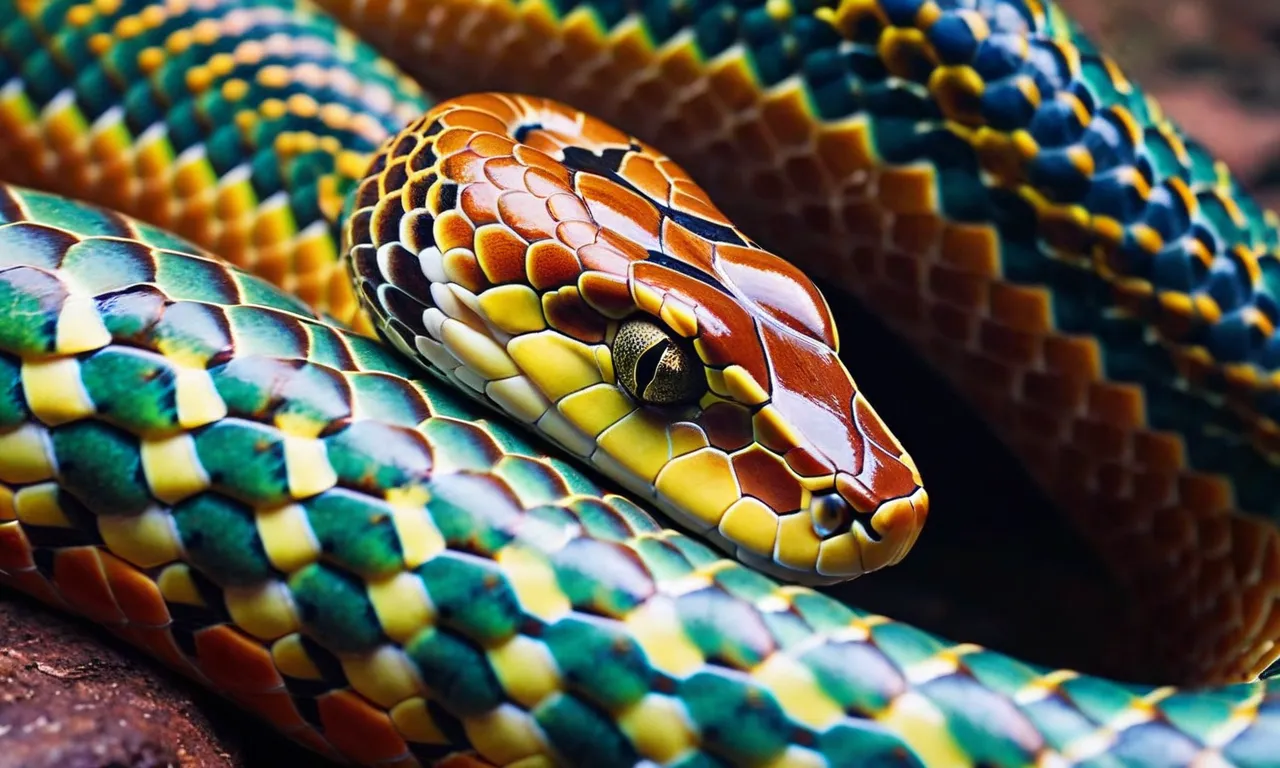Why Did God Create Snakes? A Closer Look At Their Purpose And Meaning
Since the beginning of time, snakes have instilled both fascination and fear in humans. Their sleek, slithering bodies and venomous bites seem at odds with the rest of creation. So why did God make these crawling creatures?
If you’re pressed for time, here’s the short answer: God created snakes and gave them the ability to cause harm as part of nature’s balance and an illustration of spiritual truths.
In this comprehensive article, we’ll explore what Scripture and Christian tradition have to say about the deeper meaning and purpose behind God’s design of snakes. We’ll look at how snakes play an important ecological role as predators, fit symbolically into Biblical stories and prophecies, and can teach us spiritual lessons.
By the end, you’ll have a much fuller understanding of the intriguing question: why did God make snakes?
Snakes Play a Vital Role in Nature’s Food Chain
As Predators, Snakes Help Control Populations of Other Animals
Snakes play an important role as predators in maintaining balance within their ecosystems. As carnivores, snakes help control populations of rodents, insects, amphibians and other small animals that could otherwise grow out of control.
For example, rattlesnakes feed on prairie dogs and ground squirrels that can damage crops and grasslands when overpopulated.
According to wildlife experts, snakes help restrict the spread of infectious diseases by consuming disease-carrying rodents. One report showed that in areas without snake predators, mouse populations increased by as much as 90%, spreading more ticks and Lyme disease.
So by preying on small mammals, snakes may actually protect other species, including humans, from potential epidemics.
Snakes are a Food Source for Other Predators
While snakes play the predator role in ecosystems, they also provide an important food source to other carnivorous animals higher up the food chain. Many birds, mammals, and reptiles prey on snakes, including hawks, eagles, badgers, foxes, raccoons, king snakes and even some species of snake that are cannibalistic!
Young snakes have an especially high mortality rate, as they are vulnerable to attack from many different predators. But losing many juveniles each year helps keep snake populations under control so that they don’t deplete resources other animals rely on.
Snakes are a key component of nature’s checks and balances. They serve both as predator and prey within interdependent food webs. Removing snakes could upset natural equilibrium and cause consequences to ripple through the ecosystem.
So while their presence may make us uncomfortable at times, snakes in fact fill necessary roles in maintaining biodiversity.
Snakes Feature Prominently in Key Bible Stories
The Serpent in Eden
The serpent first appears in Genesis 3 as the creature that tempts Eve to eat the forbidden fruit. This cunning snake twists God’s words and convinces Eve to disobey (Genesis 3:1-5). Most biblical scholars view the serpent as Satan incarnated as an animal.
The serpent’s deception leads to the first sin and the downfall of mankind. As punishment, God curses the snake, saying “Cursed are you above all livestock and all wild animals!” (Genesis 3:14).
Moses and Aaron’s Staffs Turning into Snakes
When Moses first appears before Pharaoh, God instructs him and Aaron to throw down their staffs as a sign of their authority. Aaron’s staff turns into a snake, but Pharaoh’s sorcerers copy the miracle. However, Aaron’s snake swallows up their snakes, proving God’s power (Exodus 7:8-13).
Here, the snakes symbolize worldly power and magic, which God’s followers prove they have authority over.
The Bronze Serpent Raised by Moses
During the Israelites’ wilderness wanderings, God sends venomous snakes to punish the people for their ingratitude and doubt. Many begin to die from snakebites. The people plea to Moses who intercedes for them. God tells Moses to make a bronze snake and put it on a pole.
All who look at it recover (Numbers 21:4-9). Jesus later uses this story as a symbol of his death and resurrection, saying “Just as Moses lifted up the snake in the wilderness, so the Son of Man must be lifted up” (John 3:14).
Vipers and Adders Mentioned in Scripture
The Bible contains over 30 references to vipers and adders, two types of venomous snakes. They are used to demonstrate the deceit and danger of sin. For example, John calls the corrupt Pharisees and Sadducees a “brood of vipers” (Matthew 3:7).
He warns them to “produce fruit in keeping with repentance.” Jesus also uses the image of parents not giving their children snakes when they ask for food to show that God does not try to harm his children, but gives good gifts (Luke 11:11-12).
Overall, biblical serpents illustrate both temptation and deception, but also God’s healing power and ability to turn symbols of sin into representations of salvation.
Snakes Can Symbolize Important Themes and Realities
Snake Venom Illustrating Sin’s Destructive Power
The venom of certain snakes contains toxins that can cause excruciating pain, tissue damage, paralysis, and even death. This points to the destructive power of sin in our lives. Just as snake venom can spread through the body and wreak havoc, sin can penetrate deep into our hearts and corrupt every part of our being (Jeremiah 17:9).
Shedding Skin as a Picture of Renewal and Rebirth
Snakes periodically shed their outer layer of skin in a process called ecdysis. This allows them to grow, removes parasites, and boosts skin and eye function. For believers, this can picture the new life we find in Christ as we “put off our old self” and are spiritually renewed (Ephesians 4:22-24).
Just as snakes emerge shiny and vibrant after shedding skin, we are “created after the likeness of God in true righteousness and holiness” (Ephesians 4:24 ESV).
Danger of Snakes Representing Struggle Against Evil
Throughout history, snakes have been seen as cunning, deceitful predators. They elicit fear due to their potential to inflict harm. Spiritually, this reveals that we are in a battle between good and evil.
Satan is depicted as “that ancient serpent” (Revelation 12:9) who seeks to lead humanity astray, while believers must remain sober and alert against his schemes (1 Peter 5:8). As snakes can strike when least expected, we must take care that sin does not ensnare us (Hebrews 3:13).
Medicinal Uses Pointing to Christ’s Atonement
Remarkably, the toxins that make certain snake venoms so potent are now being used to develop treatments for pain, heart disease, and even cancer. What was meant for evil is now bringing hope of healing.
This foreshadows how Christ’s death brought redemption, transforming the darkest day in history into the means of salvation for all who believe (Acts 13:38-39). As snake toxins point toward cures, Christ’s sacrifice provides the ultimate cure for humanity’s sin.
Guidelines for How to Think About Snake Encounters
Stay Calm and Avoid Sudden Movements
When you encounter a snake, it’s crucial to remain calm and avoid making any sudden movements. Snakes tend to bite when they feel threatened, so panicking or trying to flee dramatically raises your chances of being bitten. Instead, stay still and allow the snake to retreat on its own.
Back away slowly once it starts slithering away. Avoid reaching out to touch or pick up the snake – this will likely provoke a defensive bite.
Identify Type of Snake Before Acting
If possible, try to identify the type of snake you have encountered before taking any action. This will allow you to assess the actual danger level. For example, nearly all snake bites in the U.S. are from venomous pit vipers – rattlesnakes, copperheads, cottonmouths/water moccasins.
These have trademark triangle-shaped heads. Most other snakes are harmless. Identifying markings or using a snake ID app can help you determine if the snake poses a major threat. If it’s non-venomous, simply leaving it alone is likely the safest course.
If you confirm it is venomous, retreat and call for professional removal.
Leave Snakes Alone Whenever Possible
In most cases, the best approach when encountering a snake is to leave it alone and give it space. Snakes are not aggressive by nature and usually only bite when threatened or accidentally stepped on. Back away to a safe distance and allow the snake to retreat to a hiding spot.
Unless the snake is venomous and poses an immediate risk, avoid trying to capture or kill it – this is when many bites occur. Letting the snake be keeps both you and the snake out of harm’s way.
An exception is if the snake is located in an area that puts people or pets at high risk – such as a yard, popular hiking trail, or playground. In these cases it may be sensible to call a professional wildlife removal service to safely relocate the snake.
But in general, simply leaving snakes in peace is the wisest policy.
Closing Thoughts on God’s Purpose for Creating Snakes
As we conclude our exploration of why God created snakes, some final thoughts come to mind. Snakes fill an important role in ecosystems around the world as both predator and prey. Their unique physical characteristics, behaviors, and adaptations allow them to thrive in a diversity of habitats.
While snakes may strike fear into many humans, they are not inherently evil creatures. As part of God’s creation, snakes contribute to the balance of nature. Their presence reminds us that danger exists in the world, but we can choose whether to react in fear or respond with wisdom and caution.
Snakes Reflect Important Spiritual Truths
On a symbolic level, the snake’s winding, sinuous shape evokes spiritual themes of cyclicity, consciousness, and enlightenment. Shedding its skin represents regeneration, rebirth, and new beginnings. Venom can be seen as transmuting poison into medicine – the snake’s ability to kill also contains the power to heal.
As creatures that inhabit the ground, snakes maintain connection to the earth. Yet as climbers, burrowers, swimmers, and occasionally tree-dwellers, they also mediate between realms – linking the underworld, earth’s surface, and tree canopy.
This intermediary nature speaks to bridging dualities and overcoming separation.
Coexisting Mindfully with Snakes
Learning to coexist safely with snakes begins with understanding – recognizing their significant ecological roles as well as appreciating snake symbolism across cultures. While vigilance around venomous snakes is wise, through education we can respond judiciously instead of reacting through blind fear.
Rather than vilifying snakes, we would do well to regard them as teachers – their flexibility, sensory capabilities, and periodic renewal containing lessons in resilience. Shedding anxiety about snakes allows us to inhabit nature more peacefully and derive insight from these mysterious creatures.
Conclusion
In examining key biblical stories, symbolic meanings, ecological roles, and practical safety guidelines, we’ve uncovered many facets of God’s purpose for creating snakes. While we may never fully understand everything in our fallen world, we can rest assured that God has good plans even for slithery snakes.
The next time you encounter one of these infamous reptiles, instead of reacting in fear or judgment, consider responding with fascination, wonder, and even thanksgiving toward the Creator who formed all creatures for His glory.








